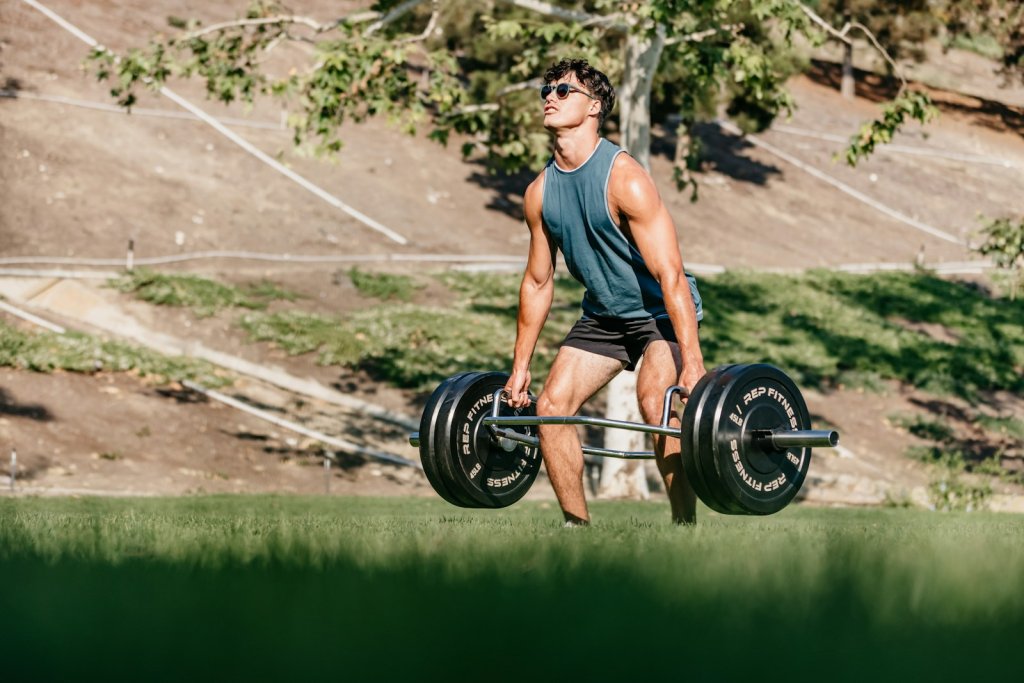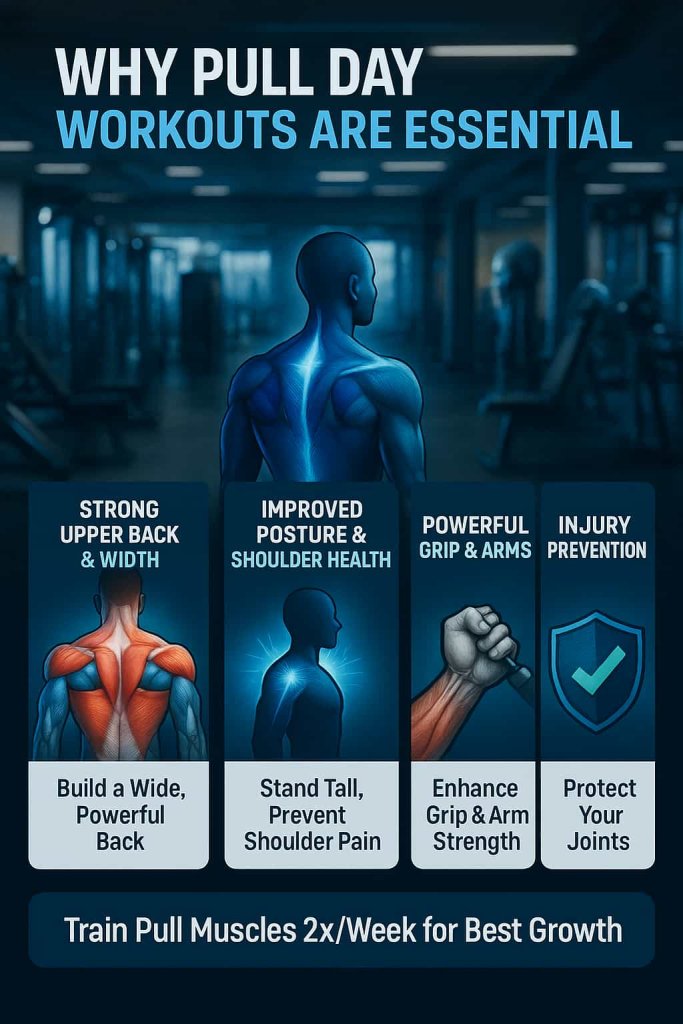The best pull day workout uses a combination of heavy compound lifts, targeted accessory moves, and up-to-date science to maximize back, biceps, and rear deltoid growth. This routine is not just popular among gym-goers—it’s recommended by elite trainers and supported by recent research.

Understanding the right pull day structure and exercise choices matters because it ensures balanced upper body development, better posture, and lower risk of injury. Whether you’re a beginner or advanced lifter, following a science-backed pull day routine will help you build muscle efficiently, improve your pulling strength, and overcome plateaus.
- Pull day = all exercises where you pull weight toward your body—mainly working the back, biceps, rear delts, and grip.
- A balanced plan means training these muscles at least twice a week for best results (PubMed, 2022).
- We’ll cover 15 proven exercises, program structure, expert tips, and common mistakes—everything you need for your next pull workout.
For official routines and videos, see Barbell Medicine’s Pull Day Guide and Gold’s Gym Pull Day Routine.
Why a Pull Day Workout Is Essential (Science & Trainer Insights)
Pull day routines target the back, biceps, rear shoulders, and grip—essential for posture, pulling strength, and a balanced physique.
Science shows training each muscle group twice a week (rather than once) leads to more muscle growth and better strength gains (PubMed, 2022). Trainers at Gold’s Gym and Barbell Medicine agree: start with compound “heavy” movements (deadlifts, pull-ups, barbell rows), then move to lighter accessory and isolation exercises.

Key pull day benefits:
- Greater muscle mass and width across the upper back
- Improved posture and shoulder health
- Stronger grip and arm flexion
- Injury prevention (especially for shoulders and lower back)
Programming tip: Mix vertical (pull-up, lat pulldown) and horizontal (rows) pulls, plus 2–3 biceps/forearm finishers for the most complete development.
The 15 Best Pull Day Exercises (Trainer Tips & Science-Backed)
Compound Lifts: The Foundation of Every Pull Day
1. Deadlift (Conventional, Sumo, or Rack Pull)
- Muscles Worked: Entire back, glutes, hamstrings, traps, forearms, core
- Why It’s : Deadlifts are unmatched for building overall strength and muscle. They stimulate more muscles at once than any other lift.
- Variations: Conventional (standard), Sumo (wide stance, less lower back stress), Rack Pull (bar starts at knee level—easier for beginners or those with mobility limits).
- Trainer Tips:
- Keep your back flat and core braced.
- Engage your lats before you lift (“bend the bar”).
- Drive through your heels, not your toes.
- Common Mistakes: Rounding your back, letting the bar drift away from your legs, yanking the bar up.
2. Weighted Pull-Up or Chin-Up
- Muscles Worked: Lats, upper back, biceps, forearms, core
- Science: EMG studies show pull-ups/chin-ups have the highest lat and upper back activation of any bodyweight move (Garage Gym Reviews, 2024)..
- Trainer Tips:
- Use full range of motion (arms straight at bottom, chin above bar).
- Pause briefly at the top for more muscle recruitment.
- Variations: Use bands for assistance or add a weight belt to progress.
- Common Mistakes: Half-reps, swinging, using momentum.
3. Barbell Bent-Over Row / Pendlay Row
- Muscles Worked: Mid-back, lats, traps, rear delts, biceps
- Science: Both activate the lats and mid-back. The Pendlay row starts each rep dead on the floor—great for power and explosiveness.
- Trainer Tips:
- Strong hip hinge: chest over bar, flat back.
- Pull bar to lower ribs, not chest.
- Common Mistakes: Jerking the weight, rounding back, using hips to lift.
Rowing Variations (Horizontal Pulls)
4. One-Arm Dumbbell Row (Kroc Row)
- Muscles Worked: Lats, lower back, rear delts, biceps, core
- Benefit: Allows a deep stretch and heavy load on each side. Great for correcting imbalances.
- Trainer Tips:
- Let your shoulder blade stretch forward at the bottom.
- Pull elbow toward your hip, not your ribs.
- Common Mistakes: Twisting your torso, shrugging your shoulder.
5. Seated Cable Row (Neutral/Pronated Grip)
- Muscles Worked: Lats, mid-back, biceps
- Science: Medium or neutral grips maximize lat activation.
- Trainer Tips:
- Sit tall, don’t lean back.
- Focus on squeezing shoulder blades together.
- Variations: Change grip width or handle style for different muscle emphasis.
- Common Mistakes: Letting shoulders round forward, leaning back too far.
6. Chest-Supported Row (Machine or T-Bar)
- Muscles Worked: Mid-back, rear delts, biceps
- Benefit: Takes stress off the lower back so you can isolate upper back muscles and train to failure.
- Trainer Tips:
- Keep chest glued to pad, don’t “pop” up at the top.
- Pull elbows behind your body for max squeeze.
- Common Mistakes: Using momentum, short range of motion.
Vertical Pulls & Accessories
7. Lat Pulldown (Medium, Neutral, or Underhand Grip)
- Muscles Worked: Lats, biceps, lower traps
- Science: Medium grip activates the lats best (PubMed, 2021).
- Trainer Tips:
- Lean back slightly, pull bar to chest—not behind your neck.
- Control the eccentric (lowering) phase.
- Variations: Wide, medium, underhand (supinated) grips all hit the lats differently.
- Common Mistakes: Using body weight to jerk the bar down.
8. Single-Arm Lat Pulldown (Half-Kneeling or Cable)
- Muscles Worked: Lower lats, core
- Benefit: Great for isolating each lat, correcting strength imbalances, and keeping tension constant.
- Trainer Tips:
- Kneel or sit tall, keep torso steady.
- Pause and squeeze at the bottom for a better mind-muscle connection.
- Common Mistakes: Twisting body, rushing the reps.
9. Inverted Row (Bodyweight Row)
- Muscles Worked: Back, rear delts, biceps, core
- Benefit: Beginner-friendly, low spinal load, and can be made harder by elevating feet or adding weight.
- Trainer Tips:
- Keep body in a straight line (plank position).
- Pull chest all the way to the bar.
- Common Mistakes: Sagging hips, partial reps.
Shoulder & Upper Back Focus
10. Face Pull (Cable/Band)
- Muscles Worked: Rear delts, rotator cuff, traps
- Science: Face pulls improve posture, shoulder health, and prevent injuries(Men’s Health, 2024)..
- Trainer Tips:
- Pull to eye level and rotate your thumbs outward at the end.
- Use light to moderate weight for better control.
- Common Mistakes: Pulling too low, letting elbows drop.
11. Reverse Pec Deck Fly / Rear Delt Cable Fly
- Muscles Worked: Rear delts, upper back, traps
- Benefit: Balances all pressing work, builds round, healthy shoulders.
- Trainer Tips:
- Slow, controlled motion—don’t swing.
- Squeeze shoulder blades at the end.
- Common Mistakes: Using too much weight, incomplete reps.
12. Cable or T-Bar Shrug-Ins
- Muscles Worked: Upper traps, neck
- Benefit: Builds trap thickness, crucial for posture and neck support.
- Trainer Tips:
- Elevate shoulders directly up (not back).
- Hold and squeeze at the top for 2 seconds.
- Common Mistakes: Rolling shoulders, jerking the weight.
Biceps & Grip Finishers
13. EZ-Bar or Barbell Curl
- Muscles Worked: Biceps, forearms
- Benefit: Classic biceps builder, easy to load heavy, and reduces wrist strain (EZ-bar).
- Trainer Tips:
- Elbows locked to your sides.
- Don’t swing—control each rep.
- Common Mistakes: Using back to lift, flaring elbows.
14. Incline Dumbbell Curl
- Muscles Worked: Long head of biceps
- Science: Incline position creates the most stretch and highest activation in the biceps long head (PubMed, 2021).
- Trainer Tips:
- Keep shoulders back, elbows pointing down.
- Lower the weights slowly for more growth.
- Common Mistakes: Short range of motion, swinging weights.
15. Hammer Curl (Dumbbell or Rope)
- Muscles Worked: Brachialis, brachioradialis, grip
- Benefit: Builds the “outer” arm and grip strength—important for all pulling.
- Trainer Tips:
- Keep wrists neutral, squeeze at the top.
- Use slow, controlled motion.
- Common Mistakes: Rotating wrists, swinging weights.
How to Structure Your Pull Day Workout
Proven Trainer-Approved Template:
| Exercise | Sets | Reps |
|---|---|---|
| Deadlift / Pull-Up | 3-4 | 5–8 |
| Barbell Row / Dumbbell Row | 3-4 | 8–10 |
| Seated Cable Row / Chest-Supported | 3-4 | 10–12 |
| Lat Pulldown / Single-Arm Pulldown | 3 | 10–12 |
| Face Pull / Rear Delt Fly | 3 | 15–20 |
| EZ-Bar Curl / Hammer Curl | 3 | 10–15 |
- Start with heavy compound moves for strength
- Move to rows and pulldowns for back width and thickness
- Add isolation for rear delts, biceps, and grip
Training Frequency: Work back, biceps, and rear delts twice per week for optimal growth (PubMed, 2022).
Rest: 1–2 min between compounds; 45–60 sec on isolation/accessory.
Pro Tips for Load, Volume & Progression
- Progressive Overload: Add weight or reps every week.
- Grip & Angle Variation: Use wide, narrow, neutral, and underhand grips to fully activate all back muscles.
- Tempo Control: Use slow eccentrics (lowering) for more muscle growth.
- Include Face Pulls: Never skip shoulder health work.
- Monitor Total Volume: 10–14 hard sets per muscle group per week is ideal (Tom’s Guide, 2024).
- Track Progress: Use a notebook or app to track sets, reps, and weight.
Common Mistakes to Avoid
- Skipping Compounds: Never start with isolation curls—always prioritize big pulls.
- Bad Form: Rounding the back or swinging the weight increases injury risk and reduces effectiveness.
- Ignoring Rear Delts/Face Pulls: Leads to poor posture and shoulder pain.
- Overtraining: More is not always better. Quality > quantity.
- No Progression: Not increasing weight/reps leads to plateaus.
FAQ: Pull Day Training
Q: Can I swap pull-ups for lat pulldowns?
A: Yes, especially if you can’t do bodyweight pull-ups yet. Both work similar muscles; just focus on form.
Q: How many pull days per week?
A: 1–2 is standard. Most lifters do “Push/Pull/Legs” (PPL) twice per week for maximum gains.
Q: Do I need to train biceps separately?
A: Pulling exercises already work biceps, but adding direct curls maximizes growth and arm strength.
Conclusion
A science-backed, trainer-approved pull day routine is essential for anyone seeking a strong, well-balanced upper body and long-term health.
Train all pull muscles twice a week, mix vertical and horizontal pulls, focus on form, and track your progress. The 15 exercises above, combined with smart programming and pro tips, will help you build a powerful back and arms for life.
